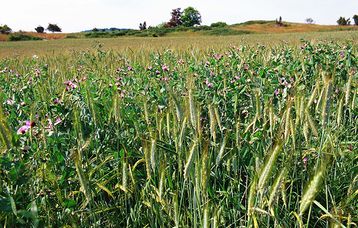Including more legumes in crop rotations.

MOMENT OF INNOVATION..
INNOVATION STATUS.
N2O emissions from agriculture, derived from nitrogen fertilizers, can be reduced by more rational and efficient fertilization practices (see here), but also by introducing legumes into crop rotations and grasslands. Fixing nitrogen from the air, these species do not need any nitrogen fertilizer; the nitrogen they leave in the soil also makes it possible to reduce the fertilization of the next crop.
The innovation aims to increase the share of grain legumes in field crops and the proportion of forage legumes in temporary grasslands. The introduction of leguminous seeds in arable crops strongly modifies the cultural succession and thus the rotation and the agricultural productions at the national level; substitution of species in grassland does not have such effects.
In fields, the goal is to introduce more legumes to replace other annual field crops. This sub-action therefore modifies crop rotations and successions, as well as the techniques on the productions following the cultivation of legumes.
In grassland, the aim is to increase the proportion of legumes in the rotated temporary grassland (as a partial or total replacement for grasses) and, in the case of mixed cover crops, to maintain the legume during the life of the grassland. This should limit nitrogen fertilization to prevent the grass from competing too strongly with the legume.
The inclusion of legumes in rotations has beneficial environmental impacts in terms of the use of crop protection products at the scale of the succession of crops, the use of water (in comparison with other summer crops), fossil fuel consumption, and biodiversity. The introduction of a new crop in the rotation is generally favorable to a more comfortable work management, appreciated by the producers, and should thus constitute a factor favorable to the development of these cultures.

